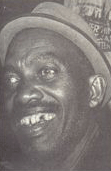| Pink travelled with Kerr until 1945, when the good
doctor retired. In the early days Pink sang a little,
danced and told a few jokes: "I couldn't play nothing
but 'bastopol' tuning when I started on guitar. You
know, 'John Henry' and songs like that".
In 1916 Pink met Simmie Dooley, a blind singer much
older than himself, living in Spartanburg. With Simmie
he became a blues singer. When Pink wasn't out with
the Indian Remedy Company, he and Simmie played at picnics
and parties in small towns around Spartanburg, like
Woodruff and Roebuck.
Pink's musical life with Simmie was very different
from his stage life. They'd go into the woods to practice,
usually with a bottle of corn Whiskey to help their
throats, and Simmie would sing the songs over and over
until Pink got the chords. Sometimes Simmie would cut
a switch and hit at Pink's hands if he kept missing
a change.
Pink recalled playing at a country club party, after
he'd spent the entire day sitting on a log in the woods
behind the golf course trying to learn the chords for
'The stars and stripes forever'. His hands were so swollen
from Simmie’s switch that he could hardly play.
With Simmie, Pink made his first recordings: two
sides for the old Columbia 1400 series, made in Atlanta
in the late '20s. Columbia tried to get him into the
studio again without Simmie, but Pink refuse, and it
was not until the early '50s that Paul Clayton heard
him playing at a fair and recorded him again, doing
a group of his favourite medicine show tunes.
After Dr. Kerr's retirement in 1945, Pink worked
less and less, preferring to stay near his home in Spartanburg.
He kept a small guitar, washboard and harmonica trio
working until 1957, when heart troubled forced him into
retirement.
After Simmie's death in December 1960, Pink made
a few recordings, including his appearance in a film
called The Bluesmen (1963). Otherwise, he mainly played
for friends, and taught songs to his son.
Pink Anderson died in 1974.
Note that while all of the Pink Floyd books refer
to Pink as a Georgia bluesman, possibly because his
early recordings were cut in Atlanta , he is in fact
a son of Carolina. Furthermore, his singing is said
to characterize a style associated with the red clay
hills of the western Carolinas. One of his album covers
states: "A singer from the flat glare of the sun on
the Mississippi Delta seems to shout his anger and his
pain, while a singer from the Carolinas seems to sing
with a melancholy shrug..." His singing is said to be
comparable to Blind Boy Fuller, a more well known Carolina
singer.
According to bluesman Paul Geremia, who opened for
Pink at a series of dates shortly before the latter's
death, he was unaware Pink Floyd the Floyd's appropriation
of his name: "I don't think I even realized that till
after he was dead."
Geremia had sought out Pink in the early '70s: He
was living in very poor conditions in a little house.
That cost him $50 a month. That was two-thirds of
Pink's retirement income. To supplement it, Geremia
said, "He was running card games at his house, and selling
booze to people, moonshine, or whatever he could get".
"It's too bad. The guy was a real important person,
culturally speaking, and he was virtually ignored. Even
his neighbours had little inkling that he was a musician".
|



